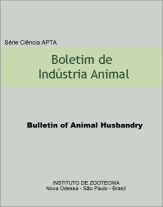PHYSICAL ATTRIBUTES OF A DYSTROPHIC REGOLITHIC NEOSOL UNDER PASTURE SUBMITTED TO MECHANICAL FORAGE HARVESTING OR ANIMAL GRAZING
DOI:
https://doi.org/10.17523/bia.v74n3p169Keywords:
compaction, infiltration, mechanization.Abstract
Cattle grazing and the use of machines for different operations such as tillage, sowing, cropping and harvesting in Brazilian soils have been indicated as the main cause of soil compaction. This effect reduces root growth and development and increases the loss of nitrogen due to denitrification and soil erosion due to reduced water infiltration. The objective of this study was to evaluate the physical attributes and basic water infiltration rate in a Regolithic Neosol under pasture submitted to different types of management (extensive grazing and mechanical forage harvesting). The study was conducted on the Roçadinho Farm, municipality of Capoeiras, Agreste de Pernambuco, under Buffel grass (Cenchrus ciliares L.) in a continuous grazing system of cattle, with an average stocking rate of 2 animal units (dairy cows with a mean live weight of 450 kg), and under growth of the same forage. Both areas were established more than 5 years ago, with mechanical forage harvesting where the harvester is coupled to the tractor and with trailer hitch. A completely randomized experimental design was used, with application of the F test at a 5% level of significance. Continuous grazing resulted in greater penetration resistance and bulk density and lower soil porosity compared to the area submitted to mechanical forage harvesting, as well as a lower basic soil infiltration rate. Animal trampling causes greater soil compaction than mechanical forage harvesting. Consequently, the extensive pasture area exhibits greater penetration resistance and bulk density and a lower total porosity and water infiltration rate in the superficial soil layer.Downloads
Downloads
Published
Issue
Section
License
Os autores não serão remunerados pela publicação de trabalhos, pois devem abrir mão de seus direitos autorais em favor deste periódico. Por outro lado, os autores ficam autorizados a publicar seus artigos, simultaneamente, em repositórios da instituição de sua origem, desde que citada a fonte da publicação original seja Boletim de Indústria Animal. A revista se reserva o direito de efetuar, nos originais, alterações de ordem normativa, ortográfica e gramatical, com vistas a manter o padrão culto da língua e a credibilidade do veículo. Respeitará, no entanto, o estilo de escrever dos autores. Alterações, correções ou sugestões de ordem conceitual serão encaminhadas aos autores, quando necessário. Nesses casos, os artigos, depois de adequados, deverão ser submetidos a nova apreciação. As opiniões emitidas pelos autores dos artigos são de sua exclusiva responsabilidade. Todo o conteúdo deste periódico, exceto onde está identificado, está licenciado sob a Licença Creative Commons Attribution (CC-BY-NC). A condição BY implica que os licenciados podem copiar, distribuir, exibir e executar a obra e fazer trabalhos derivados com base em que só se dão o autor ou licenciante os créditos na forma especificada por estes. A cláusula NC significa que os licenciados podem copiar, distribuir, exibir e executar a obra e fazer trabalhos derivados com base apenas para fins não comerciais.













